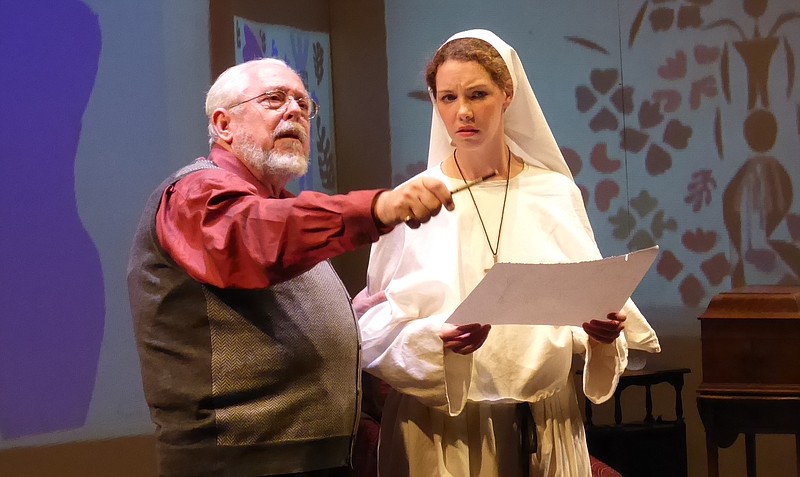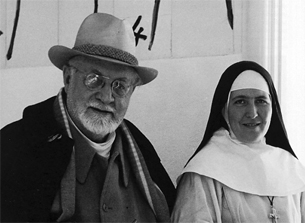User-Friendliness Is Key in Fine ‘Color of Light’
There’s a scene in The Color of Light, Vantage Theatre’s current entry at Tenth Avenue Arts Center, wherein French artist and central character Henri Matisse recalls Impressionist Pierre-Auguste Renoir’s fortitude in the face of the untold.
To hear Hank spin it, Renoir’s arthritis was so painful that he had to fasten his brush to his hand en route to a work’s completion — yet there sat the artist all the while, insisting that the discomfort was a small price to pay for a job well done.

Henri Matisse (O. P. Hadlock) and Sister Jacques-Marie (Cecily Keppel) talk art and religion as freely as they discuss whatever’s on that paper. Courtesy photo.
Little did he suspect that he was about to orchestrate the most selflessly wondrous act of his career — and with this very good world-premiere true story mounted in association with Talent to aMuse Theatre Company, we track his closely held thoughts on religion, art and the unlikely providence that wrought the power of love as its own reward.
The bombs of war peppered the outskirts of Nice like so many spider hawks in 1942, the year Matisse underwent intestinal cancer surgery and subsequently took to a wheelchair. Now 73, he would hire 21-year-old nursing student Monique Burgeois as his “young and pretty” caregiver — and amid Monique’s aspirations to the Dominican sisterhood, the two would engage in spirited debate about art and religion.
Matisse, an avowed atheist, insisted that his self-described “Church of Art” is the morally superior, while the soon-to-be Sister Jacques-Marie would devote her life to the glory of God versus His Name alone. Monique was fast becoming a granddaughter figure amid a gentility and grace only a granddad could love. With her departure, the artist is thunderstruck.
The cool thing about this story is its utter lack of pretense between the principals.
Five years later, the two meet in Vence, just northwest of Nice and the locale of Jacques-Marie’s convent, whose chapel bore a relentlessly leaky roof. She hopes to get the old man to design a stained-glass window as a repair fundraiser — but he would go her many times better, creating a new chapel in her name and that of the Dominican order.
The Chapelle du Rosaire de Vence today stands on a street named for Matisse. The artist died in 1954, Jacques-Marie in 2005.
The cool thing about this story is its utter lack of pretense between the principals. New York writer Jesse Kornbluth and La Jolla director Robert Salerno have absolutely no axes to grind amid the characters’ debates, smartly shifting the onus onto a series of secondary figures. Matisse and Jacques-Marie are no less adamant in their points of view, but they ultimately agree to disagree, thereby setting the tone for one of the greatest platonic love stories contemporary art has come to know.
But for a play about the color of light, the piece does come up short on the settings. While the rear projections of warfare and of Matisse’s works are effective, they’re also left adrift amid the lack of descriptors that may have inspired the artist and, therefore, the debates. Even in wartime, Nice and Vence were lovely cities, but Kornbluth neglects to give them their due as such, and some of the particulars are thus lost in the translation.
Please understand that this takes nothing away from the turn by O. P. Hadlock, who bears a striking resemblance to Hank and who retains much of his intense joviality in the face of illness. Cecily Keppel provides an interesting contrast between Monique’s pre- and post-convent lives –but even as she’s been well-coached, she has a tendency to anticipate her characters’ reactions.

The real Matisse died in 1954. Fifty-one years later, Sister Jacques-Marie followed suit. Public domain photo.
Lush strains from Frederic Chopin and Wolfgang Amadeus Mozart color Hadlock’s rustic, monoframe set, ideal amid Salerno’s stage pictures. Salerno, associate designer Michael Barahura and costumer Sheeila Rosen complete the tech crew, which arguably performed yeoman service in ironing out the potential kinks.
“Conflict” is a playwright’s much sought-after commodity, and as such, it’s a loaded word. Even so, it can come in many forms, just like the characters that steward it. Here, Kornbluth and Salerno take it for what it is — the foundation for a unique and loving relationship between church and state and the fuel for a slice of history that might otherwise been left unearthed. Very, very nice.
This review is based on the matinee performance of Jan. 14. The Color of Light runs through Feb. 3 at Tenth Avenue Arts Center, 930 Tenth Avenue downtown. 619-940-6813, vantagetickets.com.

Martin Jones Westlin, principal at editorial consultancy Words Are Not Enough and La Jolla Village News editor emeritus, has been a theater critic and editor/writer for 25 of his 47 years…
More…
